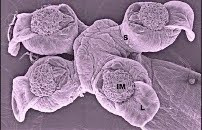 A new article about Mediterranean striped dolphins'abundance, by former Tethys' collaborator Giancarlo Lauriano, coauthored by Tethys' researchers Giuseppe Notarbartolo and Simone Panigada.
A new article about Mediterranean striped dolphins'abundance, by former Tethys' collaborator Giancarlo Lauriano, coauthored by Tethys' researchers Giuseppe Notarbartolo and Simone Panigada.
Giancarlo Lauriano, Simone Panigada, Roberta Canneri, Marta Manca Zeichen and Giuseppe Notarbartolo di Sciara
Abundance estimate of striped dolphins (Stenella coeruleoalba) in the Pelagos Sanctuary (NW Mediterranean Sea) by means of line transect survey
J. Cetacean Res. Manage. 11(3): 279–283, 2010
To assess cetacean densities in the Pelagos Sanctuary for Mediterranean Marine Mammals a survey was carried out in the Ligurian-Provencal Basin (NW Mediterranean) in August 2008. An area of 58,000 km2 was surveyed in eight days with equally spaced zigzag transects, covering 1,255 km in favourable conditions. Fifty three sightings of four cetacean species were made: striped dolphins (n = 37), fin whales (n = 12), sperm whales (n = 3) and Cuvier’s beaked whales (n = 1). Estimates of abundance were obtained using Distance 5.0.
The estimated dolphin abundance was 13,232 (CV = 35.55; 95% CI = 6,640–26,368), with a density of 0.23 individuals/km (CV = 35.55; 95% CI = 0.11–0.45). No fin whale abundance estimate was possible due to the small sample size. The point estimate of the 2008 striped dolphin abundance estimate was almost half of that of a survey conducted in 1992 by Forcada and colleagues (1995) in the same area with comparable effort, platform and methodology (25,614; CV = 25.3; 95% CI = 15,377–42,658); nevertheless, the difference was not statistically significant. These results strongly support the need for further systematic monitoring in the Sanctuary and in the surrounding areas, in order to assess striped dolphin abundance, spatial and temporal trends.
ITA Un nuovo articolo è apparso su una rivista scientifica specializzata, con coautori tra gli altri Simone Panigada e Giuseppe Notarbartolo, di Tethys. Ne emerge una stima di abbondanza delle stenelle presenti nel Santuario Pelagos: nel 2008 il loro numero sembrerebbe pressoché dimezzato rispetto a un survey paragonabile compiuto nel 1992. Il condizionale è d'obbligo perché la differenza non risulta comunque statisticamente significativa e dovrà essere ulteriormente verificata. M.J.




















